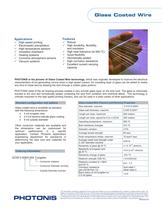
Catalog excerpts

Glass Coated Wire Features Applications High speed printing Electrostatic precipitation High temperature sensors Ionization chambers Heating systems Corrosive atmosphere sensors Vacuum systems Robust High durability, flexibility, and insulation High heat tolerance (to 650 ºC) Good flexibility Hermetically sealed High corrosion resistance Excellent current carrying capacity PHOTONIS is the pioneer of Glass Coated Wire technology, which was originally developed to improve the electrical characteristics of ion-generating corona wires in high speed copiers. An insulating layer of glass can be added to nearly any kind of metal wire by drawing the wire through a molten glass preform. PHOTONIS state of the art drawing process creates a very smooth glass layer on the wire core. The glass is chemically bonded to the wire and hermetically sealed, protecting the wire from oxidation and chemical attack. This technology is critically important to the high speed printing industry, and can be used in a wide variety of other applications. Standard configuration and options Glass Coated Wire Physical and Electrical Properties Glass coated wire is available as standard with the following dimensions: 4 mil tungsten wire 2.5 mil alumino-silicate glass coating 9 mil outside diameter Other conductor materials are available and the dimensions can be customized for optimum performance in a specific application. Contact Photonis applications engineering department for assistance in determining the best size and materials for your application. Ordering information GCW 0.009/0.004 Tungsten Conductor material Conductor Diameter (inches) Outside Diameter (inches) Wire diameter, max/min 0.012”/0.0004” Glass wall thickness, max/min 0.005”/0.0001” Length per draw, maximum 600 meters Length per draw, typical for 9 on 4 GCW 450 meters Operating temperature, maximum 650 ºC Bulk resistance changes 2%/ ºC Diameter variation 2.5% Average tensile strength 80 kpsi Axial compressive stress, max/min Average radial load strength under 0.125” diameter mandrel Resistivity of glass @ 20 ºC Resistivity of tungsten wire @ 20 ºC Resistivity change of glass 10 kpsi/1 kpsi Dielectric strength (300 ºC) Dielectric constant at 1 MHz and 20 ºC Corrosion resistance (per ASTM Part 13) Bend radius (4 mil tungsten w/ 2.5 mil glass) 9.65 lb >1 X 1017 ohm/cm >5.5 X 10-6 ohm/cm -2%/ ºC 1.6 kVDC/mil 6.9 – 7.2 Acid rated 1 Alkali rated 3 ~0.5” The information furnished is believed to be accurate and reliable, but is not guaranteed and is subject to change without notice. No liability is assumed by PHOTONIS for its use. Performance data represents typical characteristics as individual product performance may vary. Customers should verify that they have the most current PHOTONIS product information before placing orders. No claims or warranties are made as to the application of PHOTONIS products. Pictures may not be considered as contractually binding. This document may not be reproduced, in whole or in part, without the prior written consent of PHOTONIS. www.photonis.com 19/05/2010
Open the catalog to page 1All PHOTONIS catalogs and technical brochures
-
Neutronic [i]
2 Pages
-
Photonic Detector
4 Pages
-
Image Intensifier Tube ECHO
2 Pages
-
NOCTURN Cameras
4 Pages
-
Cricket
2 Pages
-
KAMELEON COLOR CMOS
2 Pages
-
Ion Beam Profiler
2 Pages
-
QUANTUM™ SUB-MINIATURE APD
1 Pages
-
NOCTURN GV Specifications
2 Pages
-
Low Light Imaging
4 Pages
-
Channeltron
4 Pages
-
Time of Flight MCP Detector
4 Pages
-
Micro Pore Optic
2 Pages
-
LongLife? MCP
4 Pages
-
NOCTURN U3 Specifications
2 Pages
-
NOCTURN MD Specifications
2 Pages
-
NOCTURN XL Specification
2 Pages
-
NOCTURN XS Specification
2 Pages
-
LYNX CMOS Sensor
2 Pages
-
NOCTURN Brochure
4 Pages
-
CPBP
2 Pages
-
MANGUM 5900 series
2 Pages
-
Spiraltron Family
2 Pages
-
Miniature CEM
1 Pages
-
FOLG
2 Pages
-
Glass Capillary Array
2 Pages
-
FieldMaster
4 Pages
-
HPD
4 Pages
-
PF1054
1 Pages
-
PF1053
1 Pages
-
Onyx
2 Pages
-
XD-4 ?
2 Pages
-
XR5? brochure
2 Pages
-
Power Supplies
1 Pages
-
Electron Multipliers
4 Pages
-
Fiber Optic Light Guides
2 Pages
-
Microchannel Plates
4 Pages
-
Hybrid Photo Diodes
4 Pages
-
Optical Receiver
2 Pages
-
Streak Tube
16 Pages
-
TOF Selection Guide
4 Pages
-
APD Selection Guide
4 Pages
-
Image Intensifier Brochure
4 Pages


![Neutronic [i]](https://img.directindustry.com/pdf/repository_di/82199/neutronic-i-877797_1mg.jpg)














































